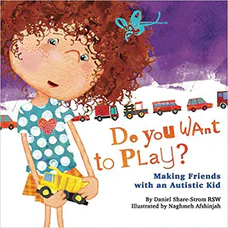Do You Want to Play?
Making Friends with an Autistic Kid
Written by Daniel Share-Strom
Illustrated by Naghmeh Afshinjah
36 pages
•
Published 2020 (ISBN Canada)

Recommended Age Range: Preschool through 2nd grade.
Publisher's Summary:
“Do you want to play?” That’s what Jamie, with her favourite yellow truck, asks new kid Dylan, who only seems to want to line up his cars. Can Jamie make a friend before Mommy comes to take her home? A heartwarming story of learning about others and finding new ways to have fun.

Dr. Annie's Takeaways
Recommended for: This book, written by an autistic author, is a celebration of parallel play and perspective taking, and it is excellent for the peers or siblings of autistic children who are minimally verbal and/or who prefer parallel play (i.e., playing side-by-side but independently) to cooperative play. This story models non-patronizing, inclusive play and encourages kids to learn to play in ways that are fun for everyone.
Would a child like it? Children who have the opportunity to play with autistic peers will likely enjoy this book. The upside down pages are fun and unique.
Evidence-Based Practices:
Psychoeducation
Tone: Cheerful, warm
Story Quality: In a (small) sea of patronizing books about befriending autistic kids, this book stands out for not being patronizing at all. It celebrates parallel play (i.e., playing independently, next to one another) and reminds kids that this can be fun for everyone. The kids’ relationship feels authentic, and the book is ultimately very sweet.
Illustrations: Pretty, textured illustrations with a bit of stylization. This book has several pages shown from the autistic boy’s perspective which require the reader to flip the book upside down to read them. It’s creative and unique, and it provides a fun, concrete reminder that a child can practice seeing things from their perspective and from another’s.
Representation: Jamie is a White, non-autistic girl with curly red hair. She has a non-autistic friend who has light colored skin and straight black hair. Over the course of the book, Jamie learns how to play with Dylan, a White autistic boy with straight, brown hair. Dylan appears to be minimally verbal (he says “yes” at the end of the book) and prefers parallel play to cooperative play. The author, Daniel Share-Strom, is autistic.
Psychological Practices: This book reminds children that parallel play is inclusive and can be fun for everyone. Parallel play refers to kids enjoying each other’s company but playing independently. It’s often one of the first ways that kids start to play with each other before they start playing cooperatively, but it continues to be a valid type of play well into adulthood (picture the warm feeling of reading a book beside a loved one). In this story, Jamie is initially confused when Dylan doesn’t respond postiively to her attempts to join his play (e.g., she asks Dylan if he wants to play and he doesn’t respond; when she tries to join in by adding drivers to his cars, he frowns and swipes the drivers off). She and her friend Caroline have a revelation while swinging quietly together that sometimes it’s fun to play quietly next to each other; they don’t always need to be interacting. Jamie then tries again to play with Dylan in a way that works for both of them. She sits next to Dylan and plays with her truck the way she likes to (vrooming around a stick highway) while Dylan plays with his cars the way he likes to (by lining them up). At the end of the book, Jamie realizes she forgot her favorite yellow truck in the sandbox, and Dylan finds her and gives it to her. It’s a poignant moment that makes the reader realize that Dylan was paying attention to her and cared that she was playing beside him. He speaks for the first time (“yes”) when Jamie asks him if he’d like to play with her again.
Concerns: Not all children are able to respond “yes” when asked if they want to play. I would remind a child reading this book that there may be other types of “green lights” that show that another child wants to keep playing with them.
Buy This Book:
Amazon
